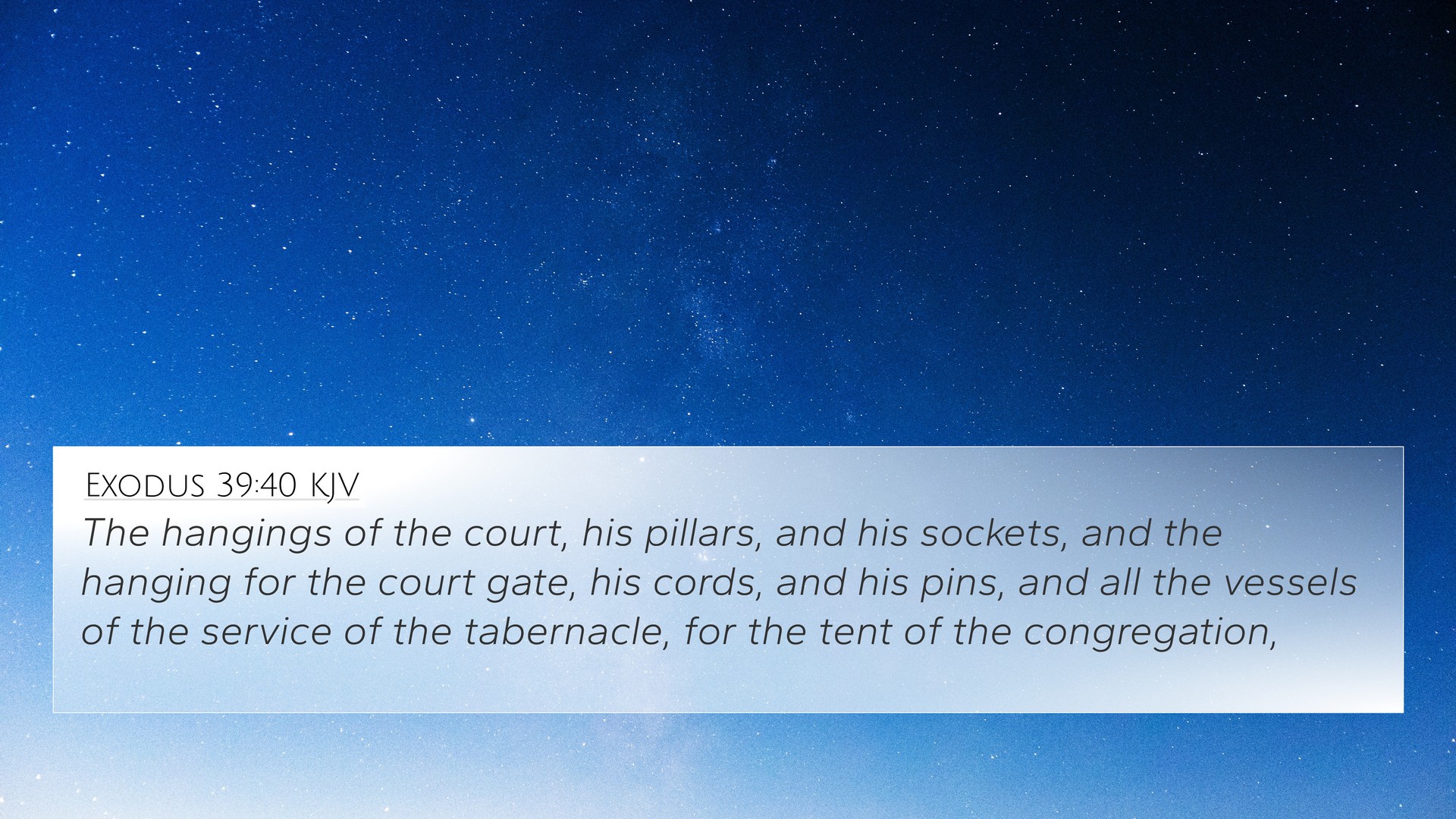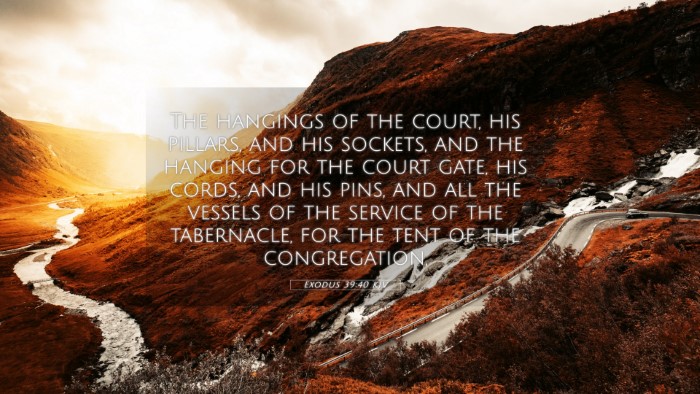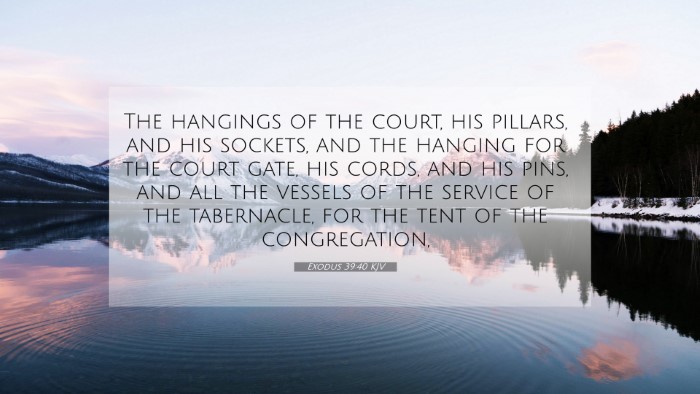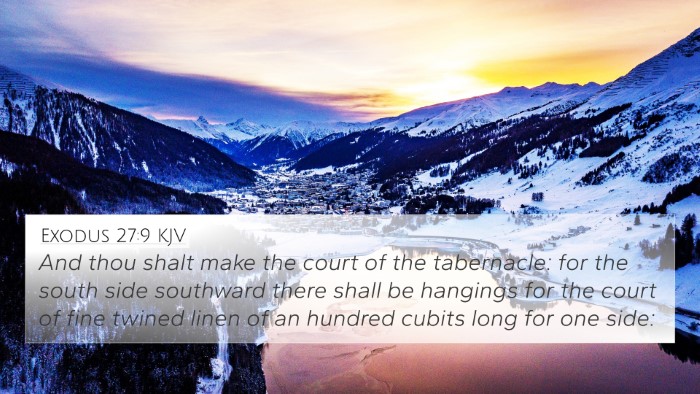Understanding Exodus 39:40
Exodus 39:40 reads:
"The hangings of the court, his pillars and his sockets, and the hanging for the door of the court, the pins of the tabernacle, and the pins of the court, and their cords,"
This verse forms a significant part of the narrative surrounding the construction of the Tabernacle, emphasizing the detailed and specific instructions given to the Israelites regarding the sacred space where God's presence would dwell.
Verse Meaning and Context
In this verse, God commands Moses regarding the final components of the Tabernacle. The meticulous nature of the instructions showcases God's desire for holiness and order within His dwelling place.
Matthew Henry's Commentary
Matthew Henry notes that this verse is a reminder of the importance of the Tabernacle in the life of Israel. It symbolized God’s presence among them and was a focal point of worship. The hangings served both a practical and symbolic purpose, veiling the holy space and thus maintaining a distinction between the sacred and the profane.
Albert Barnes' Commentary
Albert Barnes elaborates on the components mentioned, indicating that the structure not only served aesthetic purposes but also ensured that the worship of God was conducted in a manner prescribed by Him. Each element, from the hangings to the pins, contributes to the overall integrity and purpose of the Tabernacle as a place of meeting between God and Moses, and by extension, the people of Israel.
Adam Clarke's Commentary
Adam Clarke emphasizes the necessity for careful adherence to God's directives in constructing the Tabernacle. Clarke remarks on the significance of these materials as they represented offerings made by the Israelites, showcasing their devotion and the relational aspect of their worship. The detailed instructions highlight God’s desire for exactness in worship and sanctity in approaching Him.
Thematic Connections and Cross-References
Exodus 39:40 serves as a bridge to several key themes and corresponding scripture verses throughout the Bible:
- Exodus 25:8-9: The command to build a sanctuary for God.
- Hebrews 9:2: Reference to the first sanctuary and its elements.
- Exodus 26:1: Description of the tabernacle's curtains and coverings.
- Numbers 3:36-37: The responsibilities of the Levites concerning the Tabernacle.
- 1 Chronicles 28:11-12: David’s instructions for the temple, echoing the Tabernacle’s design.
- Revelation 21:3: The ultimate fulfillment of God's dwelling among men in the New Jerusalem.
- Leviticus 16:2: The significance of the holy place in relation to atonement and worship.
Cross-Referencing Techniques
In studying the Bible, utilizing cross-references can deepen understanding. Here are some methods to employ:
- Bible Concordance: Use a concordance to find related scripture based on key words.
- Bible Cross-Reference System: Look for Bibles that provide side notes or margins highlighting related verses.
- Bible Reference Resources: Explore commentaries and study Bibles that offer thematic connections.
- Cross-Reference Bible Study Methods: Engage in thematic studies that link various scriptures around a common topic.
Application and Reflection
Understanding Exodus 39:40 reminds believers of the significance of holiness and order in their spiritual lives. Just as the Israelites paid attention to detail in constructing the Tabernacle, contemporary worship requires intentionality in approaching God. This verse calls for reflection on how we structure our own lives and spaces for worship.
In Summary:
Exodus 39:40 not only illustrates the structure of the Tabernacle but emphasizes God’s desire for a relationship with His people. The careful instructions signify the importance of worship that is aligned with divine will, revealing the broader biblical themes of holiness and presence throughout scripture.
Conclusion
By exploring Exodus 39:40 alongside relevant scripture and utilizing cross-referencing tools, believers can gain a richer understanding of the Bible's teachings. The connections between verses not only illuminate individual scriptures but also provide a comprehensive view of God's overarching narrative in scripture.



